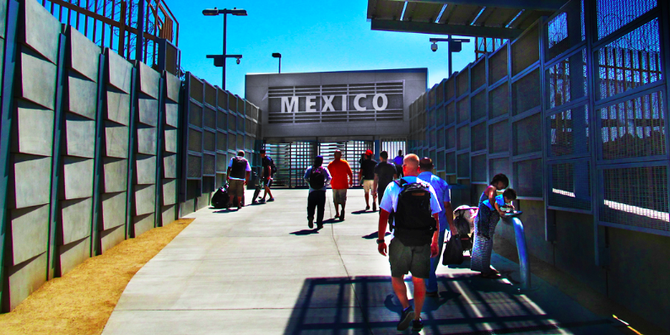 Facebook
Facebook
 X
X
 Instagram
Instagram
 TikTok
TikTok
 Youtube
Youtube

The new way to walk into Mexico via the San Ysidro route turns out to be pretty simple if one just follows instructions.
No less than six bilingual women wearing red, short-sleeved polo shirts are happy to direct you along the way, once you step off the Blue Line trolley at its last stop in San Ysidro. Signage abounds as well, but the ladies are the key to the new operation, as they direct the bewildered pedestrian along the not-so-straight but narrow path.

Part historical tour and part Stalag 17, the route wends southerly, behind the 1930s U.S. Customs House, through a canyon of 20-foot high, three-inch-thick steel bars topped with coils of razor wire. Then one passes through a pair of stainless steel turnstiles graced by a portal bearing the name “MEXICO,” all in gray steel and concrete.
Below the bas relief lettering, two new stainless steel turnstiles; one must lean their full weight into them to overcome their inertia. Once through the turnstiles, an interwoven stairway and ramp — abutted to the Mexican side of the rusty metal border fence — plummets downward some eight feet in a vertiginous emulation of an Escher drawing. Then you are in Mexico proper, in a small, tight but well-lighted room that was once part of the “last chance” Caliente betting parlor, a few feet away from the U.S. border.
Within that approximately 20´ by 20´ space, Mexican customs officials are stationed, running their routine checks while Mexican army men linger, clad in camouflage, automatic rifles slung over their shoulders. A stainless steel table stands alone for parcel/backpack inspections under fluorescent lights.
Once outside the narrow nozzle of Mexican inspection, a further plunge downward takes a traveler to street level, where one is directed to follow a recently constructed pathway to a bridge crossing over San Ysidro–bound auto traffic.


The new way to walk into Mexico via the San Ysidro route turns out to be pretty simple if one just follows instructions.
No less than six bilingual women wearing red, short-sleeved polo shirts are happy to direct you along the way, once you step off the Blue Line trolley at its last stop in San Ysidro. Signage abounds as well, but the ladies are the key to the new operation, as they direct the bewildered pedestrian along the not-so-straight but narrow path.

Part historical tour and part Stalag 17, the route wends southerly, behind the 1930s U.S. Customs House, through a canyon of 20-foot high, three-inch-thick steel bars topped with coils of razor wire. Then one passes through a pair of stainless steel turnstiles graced by a portal bearing the name “MEXICO,” all in gray steel and concrete.
Below the bas relief lettering, two new stainless steel turnstiles; one must lean their full weight into them to overcome their inertia. Once through the turnstiles, an interwoven stairway and ramp — abutted to the Mexican side of the rusty metal border fence — plummets downward some eight feet in a vertiginous emulation of an Escher drawing. Then you are in Mexico proper, in a small, tight but well-lighted room that was once part of the “last chance” Caliente betting parlor, a few feet away from the U.S. border.
Within that approximately 20´ by 20´ space, Mexican customs officials are stationed, running their routine checks while Mexican army men linger, clad in camouflage, automatic rifles slung over their shoulders. A stainless steel table stands alone for parcel/backpack inspections under fluorescent lights.
Once outside the narrow nozzle of Mexican inspection, a further plunge downward takes a traveler to street level, where one is directed to follow a recently constructed pathway to a bridge crossing over San Ysidro–bound auto traffic.
Comments